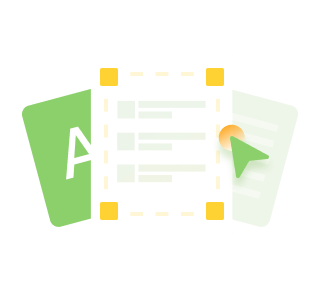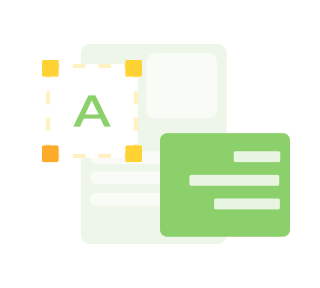Picture-to-Text OCR: Extract Text from Pictures Instantly
Optical Character Recognition (OCR) technology has become essential for efficiently converting images into editable text, particularly when managing substantial volumes of information. OCR has transformed the way we manage data from images, making it simpler to process and utilize text extracted from scanned documents, photos, or screenshots. Let’s dive into what is picture to text OCR, why it’s beneficial, and where it’s used.
Part 1: Convert Picture to Text with OCR
The mechanics of OCR technology involve advanced pattern recognition and machine learning. This section covers how OCR works, types of OCR, OCR picture to text and essential features to consider when choosing an OCR tool.
What is OCR (Optical Character Recognition)OCR, or Optical Character Recognition, is a technology that recognizes characters and symbols within images and transforms them into digital text. This process involves scanning images and recognizing individual characters, making it possible to convert image-based content into editable, searchable text. OCR technology has come a long way from its early stages, where it was limited to recognizing specific fonts. Now, it incorporates AI and machine learning, enabling higher accuracy and recognition of various fonts and handwriting styles.
Why Convert Pictures to Text?The ability to convert images to text is invaluable for many reasons. Firstly, it saves time by eliminating the need to retype text from images. It also enhances accessibility for individuals needing screen readers to access text content in images. In corporate and educational sectors, OCR can help streamline document management, data entry, and information retrieval, leading to greater productivity and efficiency.
Applications and Benefits of OCR TechnologyOCR’s versatility makes it ideal for diverse applications.
- OCR's versatility supports a range of applications, from digitizing historical archives to automating business data entry.
- Widely adopted across industries, OCR technology simplifies and speeds up document processing.
- Key benefits include increased accessibility, reduced manual effort, and faster processing times.
- OCR enables cost savings by minimizing resource-heavy data management tasks.
- Businesses benefit from streamlined workflows and automated information extraction from forms, invoices, and receipts.
Part 2: Introducing PDNob Image Translator for Picture to Text OCR Conversion
PDNob Image Translator is an efficient and reliable OCR tool that supports quick and accurate image-to-text conversion. Let’s examine its unique features, supported formats, and language capabilities, showing why it’s a standout choice for OCR tasks. PDNob Image Translator simplifies OCR with user-friendly features that make text extraction from images a breeze. It’s known for its accuracy and versatility, handling a wide range of image formats and supporting multiple languages. Whether users need to extract text from a scanned document or foreign language sign, PDNob Image Translator interface and robust OCR engine make it seamless.
PDNob Image Translator
Image to Text Converter enables you to accurately extract text from all types of images without storing any picture files into the program.
Unique Features of PDNob Image Translator
- High Accuracy Levels: Accurately recognizes complex fonts and cursive handwriting, making it ideal for diverse documents with stylized or unique text elements.
- Multilingual Capabilities: Supports over 100 languages, enabling easy processing of multilingual or mixed-language documents without needing separate tools.
- Intuitive Interface: Designed for quick and easy use, PDNob Image Translator requires minimal setup, allowing users to convert images to text seamlessly.
- Cloud and Offline Modes: Offers both online and offline functionality, making it adaptable for use in various locations and circumstances.
- Integration Options: Works smoothly with tools like MS Word, PDF editors, and other applications, enhancing productivity by streamlining text processing workflows.
Supported Formats and Language Recognition
PDNob Image Translator supports an impressive array of image formats, including JPEG, PNG, BMP, and TIFF, ensuring compatibility with standard image types. It recognizes over 100 languages, allowing users to extract text from images in multiple languages without sacrificing accuracy. Its extensive language recognition is particularly beneficial for global teams and individuals working in multilingual environments.
Part 3: Step-by-Step Guide: Converting Picture to Text Using PDNob Image Translator
This step-by-step guide explains how to convert a OCR picture to text online using PDNob Image Translator, from uploading the image to saving the extracted text.
Convert image to text free
Uploading the Image Start by uploading the image you want to convert. PDNob Image Translator allows you to select images from your local drive or drag and drop files directly onto the platform. The interface supports batch processing, so you can upload multiple images at once.

Selecting Language and Text Format Next, select the language in the image to help PDNob Image Translator achieve optimal accuracy. You can also choose the format in which you’d like the text extracted, whether plain text or a structured document, such as a Word or PDF file.

Adjusting OCR Settings for Accuracy PDNob Image Translator provides OCR settings to fine-tune recognition accuracy. You can adjust the sensitivity for handling various font types, orientations, and even low-contrast images. These settings are ideal for users working with complex documents or images containing mixed fonts and sizes.

Processing and Extracting Text After adjusting settings, proceed with the conversion. PDNob Image Translator fast processing ensures minimal wait time, and the extracted text is displayed in a preview window, allowing you to make final adjustments before exporting the text.

Editing and Saving the Text Output Finally, PDNob Image Translator lets you edit the extracted text directly within the interface. Make any needed adjustments, then save the output in your desired format. Supported export options include text files, Word documents, and PDFs, ensuring flexibility for different uses.

Part 4: Advantages of Using PDNob Image Translator
PDNob Image Translator offers several key advantages, making it an ideal OCR solution.
High Accuracy and Multilingual SupportPDNob Image Translator OCR accuracy is industry-leading, even with complex fonts and handwritten text. Its multilingual support is particularly valuable for users working with international documents or signage in various languages.
User-Friendly Interface and Fast ProcessingPDNob Image Translator user interface is designed for simplicity, with easy navigation and clearly labeled tools. Its fast processing speeds also ensure minimal wait time, allowing users to convert images to text quickly and efficiently.
Online and Offline AccessibilityPDNob Image Translator works both online and offline, allowing users to access the tool even without an internet connection. This flexibility is essential for remote work or secure environments with limited internet access.
Securing and Storing Converted DataPDNob Image Translator takes security seriously, incorporating secure storage options for converted text. This feature is beneficial for users dealing with sensitive information and needing a secure platform for OCR processing.
Integration Options with Other ToolsPDNob Image Translator compatibility with tools like Microsoft Word, Adobe PDF, and various cloud storage services makes it easy to integrate with your existing workflow. This integration allows you to streamline the process, exporting text directly to other programs without needing manual copy-pasting.
Part 5: Comparing PDNob Image Translator with Other OCR Tools
OCR analyzes image data by recognizing light and dark patterns that signify shapes and letters. Through machine learning algorithms, OCR software improves with usage, adapting to various fonts and layouts. When an image is scanned, OCR algorithms recognize and convert the visual data into digital text, which users can edit, search, and store. Advanced OCR technology can even recognize handwriting and multilingual text, making it adaptable for international applications.
Types of OCR Technology (Machine Learning-Based, AI-Powered OCR)Modern OCR technology leverages AI and machine learning to provide higher accuracy and adaptability. Machine learning-based OCR can learn from previous text recognition tasks, enhancing its accuracy over time. AI-powered OCR, on the other hand, adds predictive capabilities to OCR, enabling faster and more accurate recognition. This type of OCR can work with handwritten content, curved text, and various font styles, enhancing flexibility across different use cases.
Key Features to Look for in OCR SoftwareWhen selecting OCR software, prioritize accuracy, speed, and compatibility with diverse formats. Other vital features include:
- Multilingual support for recognizing different languages.
- Batch processing to handle multiple images simultaneously.
- Editing tools for immediate modifications to converted text.
- Export options for saving the text in preferred formats.
- Offline accessibility, which is particularly important for high-security data.
PDNob Image Translator outshines both free and premium OCR tools with its accuracy, extensive feature set, and user-friendly design.
While free OCR tools are available, they often lack the precision, language support, and robust security features offered by PDNob Image Translator. Free tools may also have limited format compatibility, making them less versatile for professional use.
PDNob Image Translator vs. Premium OCR Tools: Unique AdvantagesCompared to other premium OCR solutions, PDNob Image Translator offers a balance of high accuracy, flexibility, and affordability. Its combination of online and offline functionality, extensive language support, and secure data handling make it a standout choice for personal and professional use.
| Feature | PDNob Image Translator | Free OCR Tools | Premium OCR Tools |
|---|---|---|---|
| Accuracy | High precision | Varies; generally lower | High |
| Language Support | Extensive | Limited | Extensive |
| Security Features | Robust data security | Limited | Secure, but varies by tool |
| Format Compatibility | Broad support for multiple formats | Often limited | Broad compatibility |
| Functionality | Online and offline capabilities | Primarily online | Primarily online, some with offline options |
| Cost | Affordable, balanced pricing | Free | Often expensive |
| Ideal For | Personal and professional use | Basic or occasional use | Professional or enterprise use |
Part 6: Conclusion
OCR technology has revolutionized how we convert pictures into text, making data extraction faster, more accurate, and versatile. PDNob Image Translator stands out as a reliable and efficient OCR solution with high accuracy, language versatility, and robust security features. For users looking for a quick, accurate, and secure way to convert pictures to text, PDNob Image Translator is a top recommendation that delivers on all fronts. Its user-friendly interface and seamless integration capabilities make it an excellent choice for all image-to-text needs.
PDNob Image Translator
Image to Text Converter enables you to accurately extract text from all types of images without storing any picture files into the program.











